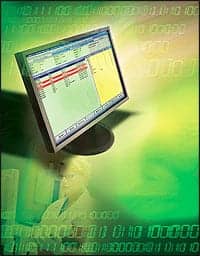 |
With the help of industry experts and laboratorians, CLP recently constructed a survey questionnaire covering the features that distinguish one laboratory information system (LIS) from another. In some cases, these features are the differences in scope that make a system more suitable than its competition for deployment in a particular hospital, reference laboratory, or outreach-focused testing facility.
In other cases, the factor that counts most may be the pricing method that makes the LIS more affordable to an institution that faces shortfalls in its capital budget, or the level of user support that lets an untrained staff learn how to work smoothly with the LIS.
The trouble taken by LIS makers to describe their products in detail should make the difficult task of choosing among competing LIS models easier, and CLP is grateful for the time that survey respondents spent clarifying the capabilities of their systems. The survey pages (presented as a pdf) summarize many of the LIS vendors’ most important responses side by side; for additional details and the companies’ answers to further survey questions, see the individual company questionnaires (presented also as pdfs) in the same article.
Based on the survey responses, it is clear that it has now become possible for a laboratory to find the right LIS for any place, procedural volume, or purpose. It is especially encouraging to note that every feature requested by laboratorians is available from at least one responding LIS vendor; the same good fit between the needs of the laboratory and the available LIS products applies to connectivity. Every kind of interface that was of interest to those laboratory personnel who helped CLP design the survey has already been installed by at least some LIS companies. These two positive findings indicate that the range of choices available to potential LIS buyers has become broader than ever before in the more than 3 decades that these systems have been in use.
LIS Capabilities
That long record of LIS implementation is one of the reasons that the field has become both broad and deep in its range of product offerings. Laboratories have been using computers to manage vital information for nearly as long as hospitals have had access to computers, beginning with the huge mainframes that were initially installed to handle billing functions and, afterward, admission/discharge/transfer data.
Patient care decisions depend so heavily on the results of diagnostic testing that laboratory reports were made available early in the development of information management in health care. Even decades ago, it was obvious that better treatment could be provided if laboratory results were made available to physicians more rapidly, especially in acute care settings such as emergency departments and intensive care units.
Often, early electronic access to laboratory results was available only through dumb terminals at nurses’ stations. This still represented a huge improvement over the need to distribute paper-based results on foot, with staff adding laboratory reports to patient charts many times each day.
Unfortunately, the laboratory’s involvement in making results available electronically was not necessarily much more efficient: typically, a clerk was responsible for keying each test result into an early version of the hospital information system, so better access to results was accompanied by a growing burden on laboratory staff (and a high possibility of error, since results were entered manually).
The clerical burden may have been a blessing in disguise for LIS development, however. The staff time involved in manual input was so costly, and the liability risk associated with data-entry mistakes was so high, that hospital executives were often willing to move laboratory information-handling capabilities forward as quickly as their budgets would permit. Based on the in-house computer expertise available, hospitals could choose prepackaged systems (and then adapt work flow to fit them), buy custom programming (at a high cost), or build their own systems (and retain the staff needed to keep them running reliably).
Fortunately, the LIS choices available today require far less work-flow revision, capital investment, or in-house maintenance. For any laboratory’s budget, expertise, and work style, there is now a commercial system. The LIS, in fact, is often described as paying for itself within a relatively short period after deployment because it can capture all applicable charges, eliminate the need to repeat work due to missing information, and distribute staff workloads evenly to make everyone more productive and less overwhelmed.
As a laboratory’s test volume increases and the list of tests that it can handle expands, an existing LIS can usually be augmented to handle the changes because many LIS vendors offer systems that can be purchased (and added to) by the piece. Likewise, initial installations can proceed step by step, with various capabilities going live one module at a time, if the laboratory chooses to proceed slowly (or must show a financial return on each part of its LIS investment before it can purchase the next capability).
No matter how complete its connectivity or how broad its array of add-on functions, though, the heart of the LIS is its ability to track every test from beginning to end, giving system users the information that they need to do their jobs throughout the process. From obtaining the specimen to sending out reports, the status of every test in progress should be clear at all times.
Of course, this tracking function is supplemented by many other capabilities: reporting, operations analysis, work distribution, staff scheduling, cost management, inventory, and directing automated instruments or systems are among the commonly desired LIS features. In laboratories, whenever the demand for a new LIS function has arisen, a developer has emerged to supply it; often, LIS vendors have built new features that laboratories did not realize were needed, but would now hate to do without.
This unusually responsive buyer-supplier relationship has allowed innovation to flourish, with continuous LIS improvement as the result. For the same reason, no vendor can create its LIS once and then sell it indefinitely. Even LIS suppliers who have been in business for many years are constantly updating their products to meet new needs and preferences.
Increasingly, these new needs involve bringing information to a broadening circle of users. In addition to distributing test results within the facility and to referring physicians, the LIS may now be expected to communicate with the electronic medical record, with surveillance systems such as tumor registries, and with far-flung physicians, whether they are at home or traveling. Besides serving medical offices and satellite facilities outside the hospital’s walls, the LIS may also need to communicate with complex information systems inside the institution, such as point-of-care instruments, picture archiving and communications systems, and clinical data repositories.
The more extensive the interoperability of the LIS becomes, the more its owners can make full use of the data it has already acquired. The ability of the LIS to bring a laboratory into the future will probably depend most heavily on its connectivity, since the LIS may be required to provide quality and compliance information directly to the information systems of insurance companies, accrediting agencies, and regulatory bodies.
Exceeding Expectations
Clearly, LIS providers have now accumulated a vast store of experience in meeting the needs of laboratories of all sizes. Some have been offering information services for as long as 35 years, and even the newest companies in this market can base their methods on the long-range results that their predecessors have seen. The more widely systems are deployed, the more all laboratories benefit from the combined knowledge gained by those who use these systems (as well as those who supply them).
Of course, new information-management challenges continue to arise in any health care setting, and laboratories are seeing their share of change. Systems that once needed to operate only within a laboratory or hospital now serve not only the entire health care enterprise, but the outreach business that generates new revenues. They must often be extended to communicate with sites ranging from one pathologist’s home to a federal disease surveillance system, and every type and size of information system in between.
For this reason, many LIS purchasers will probably consider the range and cost of available connectivity to be the deciding factor in choosing a system. Adherence to standards of information exchange is employed by an increasing number of LIS providers as the means of making information do all that it can in health care. The cost of handling information, in this sense, is expended in the initial acquisition of data; after that point, every subsequent use to which the information can be put reduces that first-input cost by squeezing more utility from the data.
Use of standards can bring the data already acquired into full use, allowing the ongoing improvement of laboratory efficiency and quality, in addition to the mining of large databases to provide the body of evidence that will make future medical decisions easier and better through retrospective research. It is this ability to gain information once, but use it in many ways over time, that distinguishes the state-of-the-art LIS from its ancestors. The laboratory that lacks these capabilities is likely, sooner or later, to find that it simply cannot meet the expectations of regulators, payors, physicians, or patients.
Kris Kyes is technical editor of CLP.




